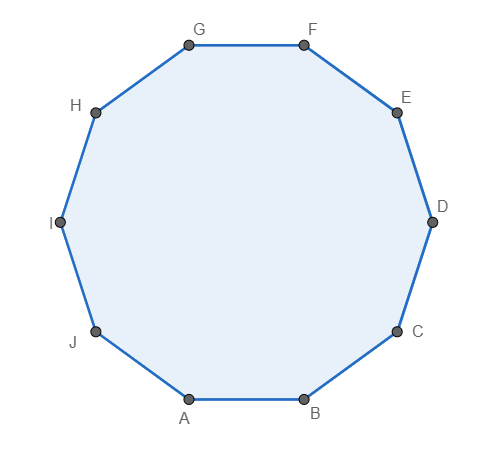
If an interior angle of a regular polygon measures $ {{144}^{\circ }} $ . How many sides does it have?
Answer
533.4k+ views
Hint: We first describe how the interior and exterior angles of an n-sided regular polygon work. We find their general values. Then using the given values of interior angle, we find the value of exterior angles. We use that to find the number of sides of the polygon from the formula of exterior angles $ \dfrac{2\pi }{n} $. If the value is an integer then a polygon exists and if the value is a fraction then the polygon doesn’t exist.
Complete step by step answer:
We know that for an n-sided regular polygon, the exterior angles would be all equal and the value will be $ \dfrac{2\pi }{n} $.
Now from the given values of interior angles, we found the exterior angles as the sum of interior and exterior angles is $ \pi $. We use that value to find if the value of n is integer or fraction. If it’s an integer then the polygon exists and if it’s a fraction then the polygon doesn’t exist.
For the interior angle $ {{144}^{\circ }} $ . The exterior angle would be $ \pi -{{144}^{\circ }}={{180}^{\circ }}-{{144}^{\circ }}={{36}^{\circ }} $ .
Now we assume the polygon is p-sided then value of the exterior angles will be $ \dfrac{2\pi }{p} $ which will be equal to $ {{36}^{\circ }} $ .
So, $ \dfrac{2\pi }{p}={{36}^{\circ }} $ . We solve it to get value of p as \[p=\dfrac{{{360}^{\circ }}}{{{36}^{\circ }}}=10\]. It’s an integer value.
The regular polygon exists and has 10 sides.

Note:
We also can use the formula of interior angles to find the values. We know that for an n-sided regular polygon, the interior angles would be all equal and the value will be $ \dfrac{\pi }{n}\left( n-2 \right) $. We put the values of the given interior angles we try to find the value of n. if they are integer then polygon exists and if the value is fraction then the polygon doesn’t exist.
Complete step by step answer:
We know that for an n-sided regular polygon, the exterior angles would be all equal and the value will be $ \dfrac{2\pi }{n} $.
Now from the given values of interior angles, we found the exterior angles as the sum of interior and exterior angles is $ \pi $. We use that value to find if the value of n is integer or fraction. If it’s an integer then the polygon exists and if it’s a fraction then the polygon doesn’t exist.
For the interior angle $ {{144}^{\circ }} $ . The exterior angle would be $ \pi -{{144}^{\circ }}={{180}^{\circ }}-{{144}^{\circ }}={{36}^{\circ }} $ .
Now we assume the polygon is p-sided then value of the exterior angles will be $ \dfrac{2\pi }{p} $ which will be equal to $ {{36}^{\circ }} $ .
So, $ \dfrac{2\pi }{p}={{36}^{\circ }} $ . We solve it to get value of p as \[p=\dfrac{{{360}^{\circ }}}{{{36}^{\circ }}}=10\]. It’s an integer value.
The regular polygon exists and has 10 sides.

Note:
We also can use the formula of interior angles to find the values. We know that for an n-sided regular polygon, the interior angles would be all equal and the value will be $ \dfrac{\pi }{n}\left( n-2 \right) $. We put the values of the given interior angles we try to find the value of n. if they are integer then polygon exists and if the value is fraction then the polygon doesn’t exist.
Recently Updated Pages
Explain the double helix structure of DNA with a labeled class 10 biology CBSE

State and prove converse of BPT Basic Proportionality class 10 maths CBSE

Which party gave the slogan Save Democracy in the Lok class 10 social science CBSE

iWhat is Rain Water Harvesting iiWhat are the advantages class 10 social science CBSE

Explain any 5 effects of the Russian Revolution of class 10 social science CBSE

Refractive index of glass with respect to water is class 10 physics CBSE

Trending doubts
Why is there a time difference of about 5 hours between class 10 social science CBSE

The Equation xxx + 2 is Satisfied when x is Equal to Class 10 Maths

The uses of bleaching powder are A It is used bleaching class 10 chemistry CBSE

Write any two uses of Plaster of Paris class 10 chemistry CBSE

What is the median of the first 10 natural numbers class 10 maths CBSE

Discuss the main reasons for poverty in India




